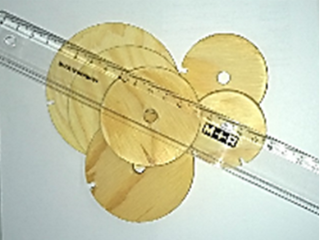More Accurate - Team E

Take disc No. 1: measure the diameter first. Use the ruler and pay attention that you measure right across the middle!

Roll the disc along the ruler on the table until the gap is on the table again. Now read from the ruler how far you have come. This is the circumference of the disc in cm.
In this manner determine the diameter and circumference of all discs and write down the measurements like this (d1 = 5 cm, c1 = ... cm) (d2 = ..., c2 = ...) ... with d1, d2, ...being your measured diameters and c1, c2, ... your measured circumferences for disc no.1, 2, ...
Have a closer look at the pairs of values. Max and Sarah are sure that there is a correlation to discover. But how? What do you discover? Make assumptions and write down your observations!
Now look at the results - do they match you assumptions? If yes, find reasons why! Or do you find another correlation - then describe it! Form a final statement about the correlation.